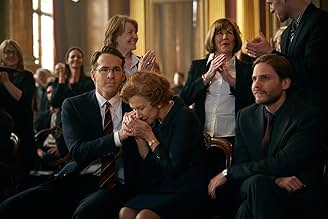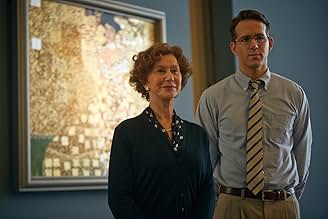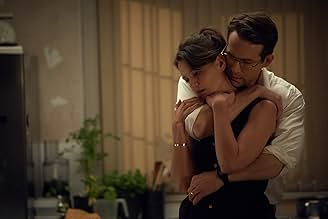PUNTUACIÓN EN IMDb
7,3/10
65 mil
TU PUNTUACIÓN
Maria Altmann, una refugiada judía octogenaria, se enfrenta al gobierno austriaco para recuperar unas obras de arte que cree que pertenecen legítimamente a su familia.Maria Altmann, una refugiada judía octogenaria, se enfrenta al gobierno austriaco para recuperar unas obras de arte que cree que pertenecen legítimamente a su familia.Maria Altmann, una refugiada judía octogenaria, se enfrenta al gobierno austriaco para recuperar unas obras de arte que cree que pertenecen legítimamente a su familia.
- Dirección
- Guión
- Reparto principal
- Premios
- 6 nominaciones en total
Reseñas destacadas
The Woman in Gold is based on the true story about a woman, Maria Altmann (Helen Mirren), and her lawyer, Randol Schoenberg (Ryan Reynolds), as they attempt to reclaim ownership of an extremely valuable painting (along with a few more) form the Austrian government nearly fifty years after it was stolen by the Nazis. This film has three distinct parts that intertwine through the duration of the show. First, there is a family dynamic that focuses on the emotional stress of the current situation on everyone's personal lives. There is a strong connection between Randol and Maria that grows over time and is given time to grow in these segments. Second, there are flashbacks that dive deeper into Maria's past and emphasize the importance of the artwork as well as explore parallels between the past and the present. Finally there is the trial itself, which is where the action of the conflict lies. This is the least important, yet still necessary part of the story. The percentage of time given to these segments would be around 40/40/20, respectively. While you might be surprised how much of the story takes place in the past, it really does drive the plot. There are many white-knuckle scenes and heart wrenching moments that really add to the film. The past is just as important as the present in this movie, and that is exactly what the film is trying to say. Helen Mirren, as always, was amazing in this film. She was subtle and drove many of the scenes that required raw emotion. Ryan Reynolds was also very good and his role in this film might have been his best performance (from what I have seen). Actually, all of the actors did a fantastic job here. Everyone was on there A-Game and gave it everything they had. There was great chemistry between Mirren and Reynolds which made their characters' connection even more compelling. Reynolds was able to subtly change his character as the case slowly changed his motivations. While, yes, there are a few clichéd scenes that were put in there for emotional levity and drama, but they don't really take much away, if anything. This was an excellent film and I highly recommend it.
Helen Mirren and Ryan Reynolds star in "Woman in Gold" from 2015, a true story about the quest of Maria Altmann to recover art stolen from her family by the Nazis in Vienna, the seat of anti-Semitism in Europe.
I just want to point out, to answer some of the reviews, that this is not a documentary, it's a movie. Movies combine events, change them around, omit them. No one wants to watch a tedious film that recognizes that it took a huge amount of time to get to the Supreme Court. If you want the actual, factual story of Maria Altmann's journey, you will need to read about it or see one of several documentaries. Films are meant to pique our interest.
Altmann speaks with a young attorney, Randy Shoenberg, about recovering The Woman in Gold, a painting by Klimt that is considered a symbol of Vienna. Klimt in fact painted a series of stunning portraits of Altmann's aunt, Adele Bloch-Bauer, who died of meningitis at the age of 44.
In her will, she asked her husband Ferdinand, who had seen the writing on the wall in Vienna and fled to Prague, to donate the paintings to the Austrian State Gallery.
Although he has just started a new job, Shoenberg travels to Vienna to see the will. Along the way there are flashbacks of Vienna in the '30s, where the Bloch-Bauer family lived in opulence. When the Nazis came to their home, they stripped the place of everything valuable - and there was a lot -- and put the family under house arrest.
Maria and her husband, an opera singer, manage to escape in a harrowing scene. In flashbacks, Maria is played by the remarkable Tatiana Maslany, the star of "Orphan Black," who looks incredibly like a brunette Mirren.
This is a touching, beautifully told story of one man's sacrifice and determination and a woman facing up to her past in order to seek justice.
Helen Mirren is one of my favorite actresses - here, she is a vibrant, energetic octogenarian who finds the struggle for the painting uncomfortable - several times, meeting a roadblock, she is ready to wash her hands of it, but Schoenberg won't let her. It represents her family to her, and some uncomfortable memories. You can see all of that in Mirren's multilayered performance.
Reynolds is excellent as a young man who believes in taking a chance - - he started and failed in his own law practice - and in this case, going for the gold, despite the fact that he has a wife (Katie Holmes), a baby, and one on the way, and an intolerant boss. It doesn't faze him and when Maria wants to quit, he is furious.
I disagree that there was no connection between them. In fact, there is a deep one. The quest for the painting comes to represent to him what it means to Maria
I highly recommend this film. There are tons of movies about the horrors perpetrated on Jews by the Nazis. The recovery of stolen art is one part of that horror. "You see a painting," she tells a group. "I see my aunt."
I just want to point out, to answer some of the reviews, that this is not a documentary, it's a movie. Movies combine events, change them around, omit them. No one wants to watch a tedious film that recognizes that it took a huge amount of time to get to the Supreme Court. If you want the actual, factual story of Maria Altmann's journey, you will need to read about it or see one of several documentaries. Films are meant to pique our interest.
Altmann speaks with a young attorney, Randy Shoenberg, about recovering The Woman in Gold, a painting by Klimt that is considered a symbol of Vienna. Klimt in fact painted a series of stunning portraits of Altmann's aunt, Adele Bloch-Bauer, who died of meningitis at the age of 44.
In her will, she asked her husband Ferdinand, who had seen the writing on the wall in Vienna and fled to Prague, to donate the paintings to the Austrian State Gallery.
Although he has just started a new job, Shoenberg travels to Vienna to see the will. Along the way there are flashbacks of Vienna in the '30s, where the Bloch-Bauer family lived in opulence. When the Nazis came to their home, they stripped the place of everything valuable - and there was a lot -- and put the family under house arrest.
Maria and her husband, an opera singer, manage to escape in a harrowing scene. In flashbacks, Maria is played by the remarkable Tatiana Maslany, the star of "Orphan Black," who looks incredibly like a brunette Mirren.
This is a touching, beautifully told story of one man's sacrifice and determination and a woman facing up to her past in order to seek justice.
Helen Mirren is one of my favorite actresses - here, she is a vibrant, energetic octogenarian who finds the struggle for the painting uncomfortable - several times, meeting a roadblock, she is ready to wash her hands of it, but Schoenberg won't let her. It represents her family to her, and some uncomfortable memories. You can see all of that in Mirren's multilayered performance.
Reynolds is excellent as a young man who believes in taking a chance - - he started and failed in his own law practice - and in this case, going for the gold, despite the fact that he has a wife (Katie Holmes), a baby, and one on the way, and an intolerant boss. It doesn't faze him and when Maria wants to quit, he is furious.
I disagree that there was no connection between them. In fact, there is a deep one. The quest for the painting comes to represent to him what it means to Maria
I highly recommend this film. There are tons of movies about the horrors perpetrated on Jews by the Nazis. The recovery of stolen art is one part of that horror. "You see a painting," she tells a group. "I see my aunt."
"Mrs. Altmann, it would seem that if your case goes forward, world diplomacy will collapse, and you will be solely responsible."
"Woman in Gold" is a wonderful and sometimes touching film. Not because of the topic as this was already highlighted in "The Monuments Men", but because of the brilliant rendition Helen Mirren is showing here. A role that suits her perfectly. A distinguished elderly lady who's a descendant of a wealthy Jewish family and who was forced to flee to the United States during Austria's annexation with Germany. She left behind everything: family, personal things and valuable belongings that were owned by the family Altmann. The resentment towards the German ruler obviously is still as lively now as it was in the past. And despite her intention never to set foot on Austrian soil again, she still makes the overseas trip to reclaim the famous painting "Portrait of Adèle Bloch-Bauer" by Gustav Klimt, since she's the rightful heir. That this invaluable piece of art was worth a fortune, is swept aside by her as irrelevant. In the end the painting has been sold to a renowned New York art gallery for a mere 135 million dollars. I'm sure at that moment it wasn't irrelevant anymore.
The film is actually twofold. Obviously there's a less successful part and an exciting second part. The first part, and least successful, is about the court case Maria Altmann starts against the Austrian state, who consider the previous mentioned painting as a national treasure. The fact that it was stolen by the Nazis and actually ended up in their hands unlawfully, was a side issue apparently. So the first thing we are presented with, is an old fashioned courtroom drama with Ryan Reynolds as the young lawyer Randol Schönberg, grandson of the famous Austrian composer Arnold Schönberg and also descendant of a family of war refugees.
The fascinating and interesting part of the film focuses on the past and present of the widow Altmann. A metered mixture of images of this zestful character these days and the painful memories weighing on her shoulders. These memories are displayed in old-fashioned-looking sepia-colored flashbacks. A sketch full of contrasts of the still traumatized Maria and the conditions in which she lived during the occupation. The humiliations and fear. When she gets back in Vienna after so many years, Mary's facial expression proves that this past still weighs heavily on her.
Helen Mirren is a kind of mixture of P. L. Travers and Queen Elizabeth. A lady behaving according to the etiquette from the upper middle class who keeps certain values and norms still alive. A stiff Victorian granny who suffers from a trauma and is seeking for justice. A kind of Miss Marple, but then still in possession of an elegant well-preserved beauty. Without any effort Mirren surpasses the young Reynold on screen. Despite his immense importance in the complex legal procedure, the character pales in comparison with the engaging, witty and sometimes tragic person performed by Mirren. Despite the fact that now and then she brings forward corny sounding quotes, she remains a credible and worthy character.
Of course you can cite that the Austrian people are portrayed in a one-sided and caricatural way and look like an anti-Semitic nation that supports the Nazi-regime. Personally, I'm convinced that it's pretty close to being true and that it's more an instinctual survival tactic than that they were supporting that ideology. But that's another discussion. Maybe the relationship between Maria Altmann and her aunt Adèle could have been worked out a bit deeper. But the acting of Mirren and the tragic images of the past create an unparalleled film filled with tragedy and justice.
More reviews here : http://bit.ly/1KIdQMT
"Woman in Gold" is a wonderful and sometimes touching film. Not because of the topic as this was already highlighted in "The Monuments Men", but because of the brilliant rendition Helen Mirren is showing here. A role that suits her perfectly. A distinguished elderly lady who's a descendant of a wealthy Jewish family and who was forced to flee to the United States during Austria's annexation with Germany. She left behind everything: family, personal things and valuable belongings that were owned by the family Altmann. The resentment towards the German ruler obviously is still as lively now as it was in the past. And despite her intention never to set foot on Austrian soil again, she still makes the overseas trip to reclaim the famous painting "Portrait of Adèle Bloch-Bauer" by Gustav Klimt, since she's the rightful heir. That this invaluable piece of art was worth a fortune, is swept aside by her as irrelevant. In the end the painting has been sold to a renowned New York art gallery for a mere 135 million dollars. I'm sure at that moment it wasn't irrelevant anymore.
The film is actually twofold. Obviously there's a less successful part and an exciting second part. The first part, and least successful, is about the court case Maria Altmann starts against the Austrian state, who consider the previous mentioned painting as a national treasure. The fact that it was stolen by the Nazis and actually ended up in their hands unlawfully, was a side issue apparently. So the first thing we are presented with, is an old fashioned courtroom drama with Ryan Reynolds as the young lawyer Randol Schönberg, grandson of the famous Austrian composer Arnold Schönberg and also descendant of a family of war refugees.
The fascinating and interesting part of the film focuses on the past and present of the widow Altmann. A metered mixture of images of this zestful character these days and the painful memories weighing on her shoulders. These memories are displayed in old-fashioned-looking sepia-colored flashbacks. A sketch full of contrasts of the still traumatized Maria and the conditions in which she lived during the occupation. The humiliations and fear. When she gets back in Vienna after so many years, Mary's facial expression proves that this past still weighs heavily on her.
Helen Mirren is a kind of mixture of P. L. Travers and Queen Elizabeth. A lady behaving according to the etiquette from the upper middle class who keeps certain values and norms still alive. A stiff Victorian granny who suffers from a trauma and is seeking for justice. A kind of Miss Marple, but then still in possession of an elegant well-preserved beauty. Without any effort Mirren surpasses the young Reynold on screen. Despite his immense importance in the complex legal procedure, the character pales in comparison with the engaging, witty and sometimes tragic person performed by Mirren. Despite the fact that now and then she brings forward corny sounding quotes, she remains a credible and worthy character.
Of course you can cite that the Austrian people are portrayed in a one-sided and caricatural way and look like an anti-Semitic nation that supports the Nazi-regime. Personally, I'm convinced that it's pretty close to being true and that it's more an instinctual survival tactic than that they were supporting that ideology. But that's another discussion. Maybe the relationship between Maria Altmann and her aunt Adèle could have been worked out a bit deeper. But the acting of Mirren and the tragic images of the past create an unparalleled film filled with tragedy and justice.
More reviews here : http://bit.ly/1KIdQMT
It was a good choice after I have read all the positive critics here. This is a very emotional true story that is well told and never boring. There were good flashbacks where all the reconstructed scenes were originally and perfectly done. I felt to be in the movie. All the actors and especially Ryan Reynolds delivered a great job. Helen Mirren put as usual a special humor note into the ambiance. It seems this role is suited to her and nobody else. The music was wonderful and I had even some tears. This movie is much more better than the other ones about the stolen Jewish paintings from the Nazi. See it. 7/10
If you like this genre of movie don't miss The Pianist, Der Letzte Zug or Die Fälscher.
If you like this genre of movie don't miss The Pianist, Der Letzte Zug or Die Fälscher.
This film tells the story of a old woman who moved to USA to escaped Nazi rule in Austria when she was young. She finds documentary proof in her late sister's belongings that several priceless paintings are stolen from her family, and are now in the possession of a state museum.
"Woman in Gold" is a beautiful film because it's a journey of three people working hard for a common goal for slightly different reasons. I'm impressed by the lawyer's enthusiasm in taking up Maria's case. He shows much dedication and professionalism. Maria's goal to take back the paintings is to keep memories alive, which is very touching. The atmosphere of the film is kept quite serious but not sombre, which is not easy for a film about the persecution of Jews. Overall, I think this film portrays a triumphant journey, and is very touching.
"Woman in Gold" is a beautiful film because it's a journey of three people working hard for a common goal for slightly different reasons. I'm impressed by the lawyer's enthusiasm in taking up Maria's case. He shows much dedication and professionalism. Maria's goal to take back the paintings is to keep memories alive, which is very touching. The atmosphere of the film is kept quite serious but not sombre, which is not easy for a film about the persecution of Jews. Overall, I think this film portrays a triumphant journey, and is very touching.
¿Sabías que...?
- CuriosidadesOprah Winfrey was, for ten years, the owner of Gustav Klimt's second-most-famous portrait of the subject of the painting unofficially known as "Woman in Gold." The second most famous Klimt portrait of Bloch-Bauer was officially titled "Adele Bloch-Bauer ll." Winfrey reportedly bought the painting anonymously in 2006, when Christie's sold it at auction for $87.9 million, during the same auction session when the subject of this film was sold, along with four other Klimt paintings owned by Maria Altmann's family. In 2016, Winfrey sold the 54"x54" painting, "Adele Bloch-Bauer II," to a Chinese collector for $150 million.
- PifiasWhen Randy Schoenberg is before the Supreme Court, he is shown being asked a convoluted question by Chief Justice William Rehnquist, whereupon Schoenberg admits he doesn't understand it. That question was actually posed by Justice David Souter. The reaction from the other justices, who also didn't understand the question, was accurately depicted.
- Citas
Randol Schoenberg: It's hard to believe Hitler once applied to be an art student here.
Maria Altmann: I wish they'd have accepted him.
- ConexionesEdited into The Spoils (2024)
Selecciones populares
Inicia sesión para calificar y añadir a tu lista para recibir recomendaciones personalizadas
- How long is Woman in Gold?Con tecnología de Alexa
Detalles
- Fecha de lanzamiento
- Países de origen
- Sitios oficiales
- Idiomas
- Títulos en diferentes países
- La dama d'or
- Localizaciones del rodaje
- Empresas productoras
- Ver más compañías en los créditos en IMDbPro
Taquilla
- Presupuesto
- 11.000.000 US$ (estimación)
- Recaudación en Estados Unidos y Canadá
- 33.307.793 US$
- Fin de semana de estreno en EE. UU. y Canadá
- 2.091.551 US$
- 5 abr 2015
- Recaudación en todo el mundo
- 61.619.773 US$
- Duración1 hora 49 minutos
- Color
- Mezcla de sonido
- Relación de aspecto
- 2.35 : 1
Contribuir a esta página
Sugerir un cambio o añadir el contenido que falta

Principal laguna de datos
By what name was La dama de oro (2015) officially released in India in English?
Responde







































